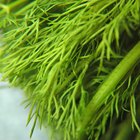
Cinnamon and allspice are both seasonings that tend to be used in sweet dishes such as cakes and cookies. Their flavors are dissimilar, although they go well together in many recipes. Cinnamon has a mellower flavor, while allspice has a stronger flavor that sometimes overpowers other ingredients. Because of its stronger flavor, it is not a good to substitute allspice for cinnamon in recipes without adjusting quantities and flavors. It is less risky to use cinnamon instead of allspice, because the mellower flavor is less likely to stand out and call attention to itself.
The Appeal of Allspice
Unlike cinnamon, nutmeg and cloves, which were originally grown in Asia, allspice is a New World plant. When fifteenth-century European explorers sailed west in search of spices from the East, they did not find the spices that were commanding high prices in Europe, but they did find allspice, which can be used in similar types of recipes. Although the flavor of allspice is similar to that of cloves, it is a bit sweeter and not quite as sharp tasting.
The Appeal of Cinnamon
Cinnamon has been used in both sweet and savory dishes since pre-Roman times, when caravans imported the spice from the Near and Far East. Cinnamon is used in Indian curries and Greek pasta dishes, as well as sugar cookies and sticky cinnamon buns. Its flavor blends well with other seasonings and also stands on its own with a rich, distinctive bite. Like the grapes used to make fine wines, cinnamon has vintages and flavors characteristic of different regions such as Ceylon and Madagascar.
Substituting Cinnamon for Allspice
If a recipe calls for allspice but you only have cinnamon on hand, this substitution will change the flavor of the dish but the cinnamon is unlikely to overpower other flavors that can hold up to the strong taste of allspice. Adding cloves and even a bit of nutmeg can bring back some of the sharpness that allspice has that cinnamon lacks. Some savory Caribbean dishes use allspice in combination with thyme, creating a flavor synergy that is unlike either of its elements. Using cinnamon in place of allspice in these dishes would not create a similar taste.
Substituting Allspice for Cinnamon
If a recipe calls for cinnamon but you only have allspice on hand, you may be better off leaving out the spice altogether. If you do want the flavor of a sweet spice in your sweet or savory dish, start with about a third of the amount that the recipe lists rather than making a direct substitution. Taste the dish in progress, and add more allspice if the flavor isn't too strong.
Related Articles
Can Cinnamon Lose Its Potency?

About Fresh Ginger Substitutes

Galangal Powder Substitute

What Is Accent Seasoning?
How to Substitute for Molasses in Baking

Classic Russian Spices

Substitutes for Ground Cinnamon

Can I Use Cumin Seeds Instead of Ground ...

Difference Between Peppermint Extract & ...

Garam Masala Substitute

Tanqueray Gin Ingredients

Substitutes For Tequila

Difference Between Clover & Orange ...

Do Spices Enhance Yeast Growth?

Baking Substitution for Rosewater

Afghan Spices

Wines to Serve With Cajun or Creole Food

What Can You Use to Substitute ...
Seasoning to Use in Place of Beau Monde

Difference Between Canned Pumpkin & ...
References
Writer Bio
Devra Gartenstein is a self-taught professional cook who has authored two cookbooks: "The Accidental Vegan", and "Local Bounty: Seasonal Vegan Recipes". She founded Patty Pan Cooperative, Seattle's oldest farmers market concession, and teaches regular cooking classes.
Photo Credits
Dynamic Graphics/Creatas/Getty Images